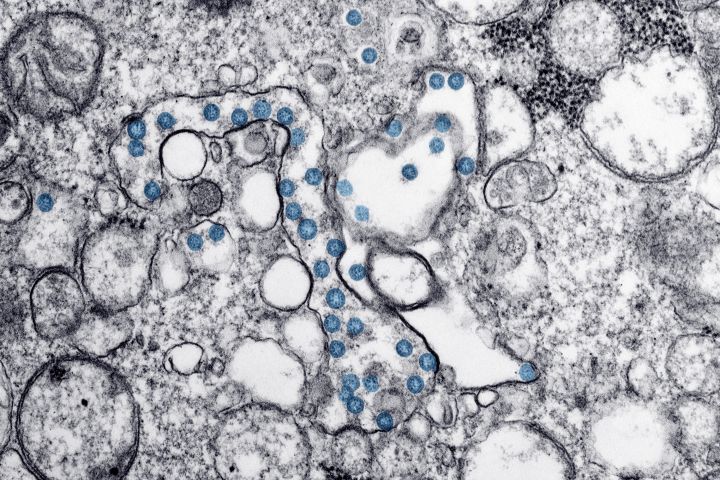Alberta’s two largest metropolitan areas appear to be seeing an increase in COVID-19. At least, that’s what the wastewater data seems to be showing.

And according to that data, the amount of SARS-CoV-2 particles being flushed into Calgary and Edmonton’s wastewater systems matches pre-Omicron highs.
The rolling average of SARS-CoV-2 levels in Calgary saw a low on March 7, and numbers have been climbing since.
“(Calgary has) been coming down a lot,” Kevin Frankowski told Global News on Friday. He is the executive director of Advancing Canadian Water Assets and co-lead of the pan-Alberta wastewater monitoring project.
“We’re about 80 per cent of the way down the Wave 5 peak, and for a while it was kind of just staying at the same level. And then the two of the last three data points (from between March 16 and March 23), it’s gone up a little bit.
“Edmonton is similar, but it hasn’t had that step up that we’ve seen in Calgary.”

He said Banff’s wastewater levels are seeing a recent upward trend, but Fort McMurray’s levels are trending downward, showing the regional nature of the pandemic in Alberta.
“I think the core message is COVID still here. We’re not out of COVID, it’s not over,” Frankowski said.
Reading the statistically-noisy graphs on the University of Calgary’s Centre for Health Informatics’ (CHI) COVID-19 tracker is most useful when looking for trends, he emphasized.
“If we see that the numbers are going up, then that can influence our decisions around (things like), ‘Maybe I won’t go to that concert,’ or, ‘Maybe I will voluntarily wear a mask.’”
Wastewater data only shows how much virus is being shed by Albertans, not how many people are sick with COVID-19.

Get weekly health news
“The reliance can’t be just on the wastewater data,” Frankowski said. “People need to also take into account the other information that’s available out there, including things like hospitalizations and ICU admissions, because what is obvious is that as the virus mutates and changes its severity, that changes its risk profile.”
Dr. David Vickers, an infectious disease epidemiologist and statistical associate at the CHI, said like in previous waves, the exact trajectory of these trends is difficult to predict.
“Given that there’s been a lot of relaxation of many of the prevention efforts going on, we might expect to see a bit of a rebound,” Vickers said, noting similar trends in PCR test positivity in the Calgary and Edmonton Alberta Health Services zones.
“Is it going to rival pre-Omicron levels? It might. It could also drop off fairly substantially.”
The epidemiologist noted a similar national trend of an upswing following a downward slope from the peak of the Omicron-driven wave.

Health Minister Jason Copping said Alberta Health and the chief medical officer of health are watching wastewater levels closely, while noting there had been a recent and “slight uptick.”
“We’re going to wait and see what happens, but we will make adjustments as needed,” he said Friday.
Recent trends in wastewater data in Calgary show the same COVID-19 RNA levels as at the peak of the third wave in April 2021. Data from Edmonton and surrounding communities shows there is as much COVID-19 RNA in the capital region as during the fourth wave of the pandemic, Frankowski said.
He said it is difficult to say if there is the same number of people sick with COVID-19 as during those previous peaks, but the trends remain.
“It’s obviously less than it was at the peak of Omicron, but it’s the same as what it was for the Delta wave,” he said. “And yet hospitalizations are way lower than they were at the peak of the Delta wave. And so that speaks to the fact that the symptoms, the severity of the disease has changed.”
Vickers noted more Albertans have received vaccine doses and naturally-acquired immunity since the fall of 2021.
And warming weather could push down COVID-19 transmission as more people get outside, Vickers said, a known phenomenon among coronaviruses.

In previous waves, PCR testing trends have followed wastewater trends by about six days in Alberta. But Alberta, like other provinces, has restricted access to PCR tests.
Vickers recognized that decision can help from a budget perspective, especially with cheaper rapid antigen tests becoming widely available. But there is a tradeoff.
“Rather than using two data sources, you’re using one.” he said. “And so it’s kind of like putting all your eggs in one basket.”
“We’ve always maintained that the wastewater data shouldn’t be used in isolation,” Frankowski added. “It needs to be paired with with other data sources, preferably clinical test results.”
The COVID-19 pandemic has been a proving ground for the ability of wastewater-based epidemiology to monitor entire populations for more than just COVID-19, and at a low cost, Frankowski said. He called it a “powerful platform.”
“Now that we’ve developed platforms, I think that we should look for ways to keep deploying the platform,” Frankowski said. “It provides a very different and very powerful tool, a new tool into the public health toolkit.
“I think it would be a shame to just walk away from that just because COVID numbers dropped below a certain threshold.”









Comments